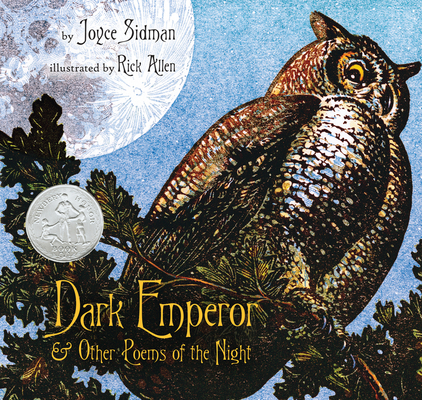I've never been a huge poetry aficionado. I read Shel Silverstein's "A Light in the Attic" as a child and remember the rhythm and rhyme of my mom and dad trying to introduce me to poetry. I remember thinking that I could write poems like Shel Silverstein. I remember with vivid memories completing my sixth grade daunting "Poetry Project," which I entitled "Modern Day Emily Dickinson," even though I'm sure I had no idea who she was at the time. After reading the chapter, particularly the portion that speaks to the dislike of poetry that many children and adults have today, I tried to read Dark Emperor and Other Poems of the Night with new eyes, eyes that really appreciated poetry. For the most part, I very much enjoyed the book. I wouldn't say I was absolutely enthralled by it or moved by every poem, but I particularly enjoyed the vivid illustrations, the glossary, and the sidebar descriptions on each page that described what the poem was "scientifically" about.
Joyce Sidman has used Dark Emperor as a book to introduce readers (who I imagine include both children and adults) to various creatures of both day and night, including spiders, porcupettes, bats, and the primrose moth. A poem appears on the left page of each pair of pages, and on the right, there is a detailed description of the creature or the actions of the creature. Although I strongly disliked the poem about mushrooms (I think that stems from my own personal hate of mushrooms), I absolutely loved the first introductory poem in the book, entitled "Welcome to the Night." It includes several onomatopoetic words (buzz, chirp, hoot, peep, etc.) and I can imagine an elementary school class being absolutely enthralled if this poem were a read aloud in their classroom. I found this video of some of the illustrations from Dark Emperor and accompanying sounds that I think would be the perfect background music to reading the book in class to students.
My favorite illustration in the book is depicted to the left, and it happens to be found on the last illustrated page of the book. It shows the sun rising in the distance, and put a smile on the face of this reader as I realized that night was finally over and the animals were back to their daily routines. I looked at the illustration technique used, and noticed that it was a technique I was surprisingly familiar with - that of relief printing. We did this in my high school art class, with linoleum blocks, and it was an absolutely fascinating process - sitting patiently carving out our desired image on a block of linoleum, then rolling ink on that, and pressing the relief of that carving onto paper. Both of these videos show the kind of detail that was needed in the illustrations in depth (here and here). I think that these illustrations only further emphasize the beautiful but almost eerie feeling that the book emits, and I thought it was wonderful.
I think that it is important to expose your class to a variety of poetry, not just Shel Silverstein, not just Emily Dickinson - but many styles and authors so that they are able to decided individually what they like and do not like. This will definitely be in my classroom library and be a staple that I include on a daily basis in both science units (interdisciplinary instruction!) and poetry.



No comments:
Post a Comment